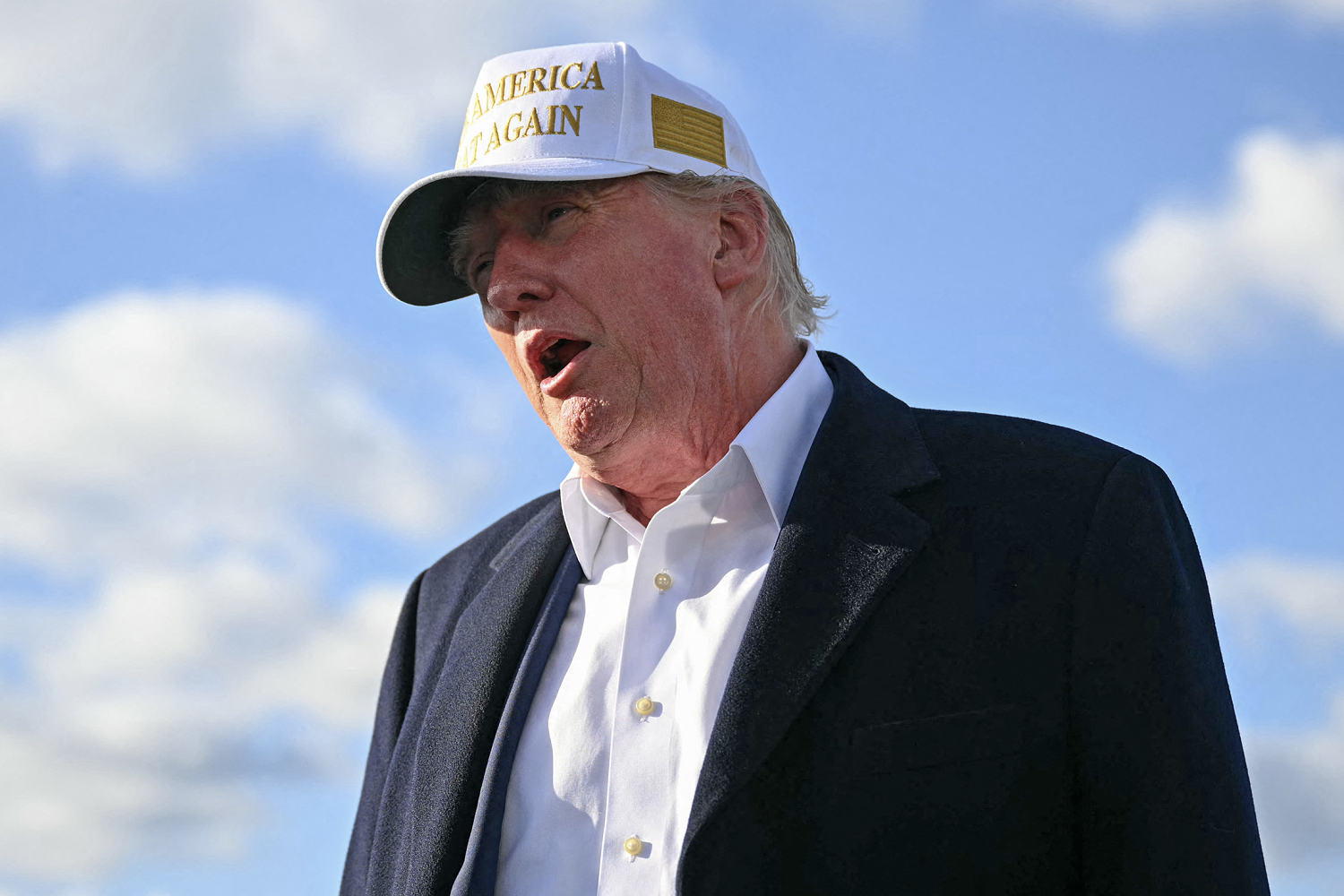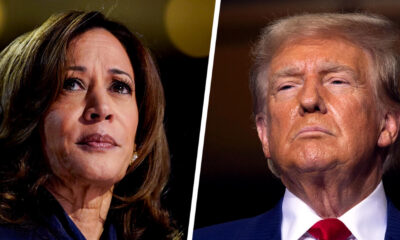The Dictatorship
The Latest: Canadian Prime Minister Mark Carney’s Liberals win election

5 people injured after older man allegedly lost control of his car in Denmark, police say
US inflation cools, consumer step up spending, as Americans brace for tariff impact
Grainy video in UK trial shows Sycamore Gap tree’s last stand
This Date in Baseball – Alex Rodriguez ties Willie Mays for 4th place on the all-time home run list
Sports on TV for Thursday, May 1
Today in Sports – 17-year old Lionel Messi scores his 1st senior league goal for FC Barcelona
Guatemala gearing up to export avocados to US despite tariffs and delays
Sports on TV for May 5 – 11
What’s that rash? Put some thought into asking Google for medical help
France is banning activist groups as presidential rivals jockey for position ahead of 2027 poll
Swiatek recovers from 0-6 loss in first set to beat Keys in ‘weirdest’ match in Madrid quarterfinals
Local elections this week are a key test for Britain’s Trump ally Nigel Farage
Storm leaves about 500K customers without power. Officials report 2 people electrocuted
Bangladesh to play 5 T20 matches in Pakistan next month
Pro wrestling icon Hulk Hogan to be commissioner of Real American Freestyle
Goalkeeper says his concussion shows soccer referees need to act faster on head injuries
What makes a Kentucky Derby champion? Big hearts, immense lungs and powerful legs
Darts player Andy Jenkins gets 11-year ban for fixing matches
Cayman Islands votes for Parliament seats and holds a referendum on possessing marijuana
European court tells Serbia to ‘prevent the use of sonic weapons’ after protesters’ claims at rally
Indian survivors of Kashmir attack say gunmen asked if they were Hindus and opened fire
Mehidy uses bat, arm to lead Bangladesh to easy win over Zimbabwe in second test
Climate change is making coffee more expensive. Tariffs likely will too
US tells World Court that Israel is not required to work with UN Palestinian refugee agency
Equipment maker Caterpillar says tariffs may increase its Q2 costs by up to $350 million
‘Top Gun: Maverick’ filmmakers drive into Formula One, with Brad Pitt and Lewis Hamilton
U.S. economy shrinks 0.3% in first quarter as Trump trade wars disrupt businesses
PHOTO COLLECTION: Germany WWII Fallen Soldiers
Oscar-winning film inspired by John and Yoko song ‘War Is Over!’ to be released as a picture book
Late photographers. Surly photographers. Here’s how to make sure wedding memories are made
The Dictatorship
I’m a food scientist. Here’s what RFK Jr. gets (mostly) right about food dye.

On April 22, the Department of Health and Human Services and the Food and Drug Administration announced measures designed to phase out all remaining petroleum-based synthetic dyes from the American food supply.
Leading the charge is Robert F. Kennedy Jr., who has pledged to Make America Healthy Again as President Donald Trump’s controversial HHS secretary. “Nobody wants to eat petroleum,” noted Kennedy recently. And petroleum-based food dyes — typically just called synthetic food dyes — are indeed derived from crude oil, the naturally occurring substance formed over millions of years from decaying plants and animals under intense heat and pressure. Part of phasing out these synthetic dyes involves transitioning to natural alternatives and accelerating their review and approval.
This shift reflects growing consumer recognition that our food system needs reform. That’s not a bad thing.
This shift reflects growing consumer recognition that our food system needs reform. That’s not a bad thing. However, real change demands more than simply removing synthetic additives. It requires a fundamental rethinking of how we produce, market and consume food in America — and a commitment to prioritizing public health over company profits.
Currently, only a handful of certified color additives are approved by the FDA to use in food. Under the Delaney Clauseof the Federal Food, Drug, and Cosmetic Actthe FDA is prohibited from approving any color additive that has been found to cause cancer in humansoranimals. And the FDA asserts that color additives are safe for consumption when used in accordance with its regulations.
The FDA plans to ban the two rarely used dyes — Citrus Red 2 and Orange B — in the upcoming months while working with the food industry to voluntarily eliminate six commonly used dyes (Red 40, Yellow 5, Yellow 6, Blue 1, Blue 2 and Green 3) by the end of next year. The three most popular remaining dyes — Red 40Yellow 5 and Yellow 6 — account for 90% of all food dye consumption in the U.S.
Under the Biden administration, the FDA had already initiated phasing out of Red No. 3. Advocates had argued for years that the dye should be banned because of research linking it to cancer in male rats at high doses.
And there are already efforts underway in various states to cut down or eliminate the dyes.
In October, California became the first state to prohibit school cafeterias from serving foods that contain six commonly used synthetic dyes. The law will go into effect in 2027, requiring manufacturers to replace these dyes with natural alternatives. West Virginia will ban the same dyes from schools this August and from all foods sold in the state in 2028. Utah and Arizona have also enacted similar laws.
There are plenty of reasons to be wary of foods that rely on synthetic dyes. Such products are typically ultraprocessed and high in fat, sugar and sodium. The cumulative effects of repeated exposure over a lifetime aren’t well understood. Additionally, there is limited research on how different additives interact with one another — and with other ingredients in the food matrix — during processing.
The concept of “dosage makes the poison” applies here, as combinations of dyes can complicate the assessment of how much artificial dye is being consumed. But at least some studies have shown worrying impacts on kids.
In the 1960s and the 1970s, U.S. tobacco companies conducted extensive market research with children and found that they preferred red products.
A systematic review of epidemiologic research on synthetic food dyes and neurobehavioral outcomes found a correlation between synthetic food dye exposure and adverse neurobehavioral effects in some children. Furthermore, the review suggested that the FDA’s Acceptable Daily Intake levels for synthetic food dyes may not adequately protect children from behavioral effects. The study also found that children and lower-income populations tend to have higher exposures, highlighting the need to improve access to healthier food options.
Compounding this problem is the fact that children are particularly attracted to colorful snacks. This isn’t a coincidence. In the 1960s and the 1970s, U.S. tobacco companies conducted extensive market research with children and found that they preferred red products. These companies later played a leading role in shaping U.S. food marketing from 1980 to 2001, developing “hyper-palatable foods” that became staples in the American diet.
Given this research and the actions being taken in some states, many U.S. food companies have already been reformulating their products. In 2015, General Mills removed artificial colors from some of its cereals — but it reinstated them two years later following consumer complaints. General Mills now offers schools a lower-sugar, artificial color-free version of Trix cerealcomplying with the new food additive laws in California and West Virginia. Kraft Heinz removed artificial preservatives, flavors and dyes from its signature macaroni and cheese recipe in 2016. To maintain its signature yellow-orange hue, Kraft replaced artificial colorsincluding Yellow 5 and Yellow 6, with natural spices like paprika, annatto and turmeric.
At the same time, “natural” doesn’t automatically mean safer or better. For example, carmine — or the less concentrated cochineal extract — is a widely used natural red dye derived from the dried bodies of female Dactylopius coccus insects. It’s also a known allergen. Because natural colors are categorized as “exempt” from certification requirements, they are subject to less rigorous safety testing compared with synthetic dyes. Natural dyes also may require higher quantities to achieve the same vibrant colors, and they are often significantly more expensive than their synthetic counterparts. As a result, both the dosage of additives and the cost of food products may increase with new formulations.
To truly “Make America Healthy Again,” we must make nutritious foods more accessible and affordable while also reducing the overwhelming presence and consumption of ultraprocessed foods. The overconsumption of these foods is directly linked to all sorts of health problems like weight gain, obesity, diabetes and cardiovascular disease. Meanwhile, healthy, whole foods remain out of reach for far too many families. Programs like Farm to Schoolwhich introduce students to locally grown produce and promote healthier eating habits, should be protected rather than halted.
But we must also resist falling into chemophobia — an irrational fear of chemicals — which only fosters unnecessary fear among consumers, makes them more vulnerable to misinformation and distracts from evidence-based solutions. Instead of superficial changes, we must confront the systemic barriers that make healthy eating a privilege rather than a basic human right.
Selina C. Wang is an associate professor in the food science and technology department at the University of California, Davis.
The Dictatorship
Trump keeps losing in court. But the relief isn’t always what it seems and might not last.

Looking back on President Donald Trump’s first 100 daysNBC News has reported that his administration has faced more than 200 civil lawsuits to date — and that these lawsuits have been largely successful, with judges across the country ordering more than 100 injunctions or pauses.
Usually, I am a glass half-full kind of girl. But lately, there have been signs that many of these injunctions are not actually stopping or preventing the actions at issue.
First, even putting aside perhaps the two most glaring examples of the Trump administration’s failure to follow court orders — the cases of Kilmar Abrego Garcia and those Venezuelan men deported and imprisoned in El Salvador pursuant to Trump’s invocation of the Alien Enemies Act — there are multiple other litigations in which the administration has skirted, if not outright flouted, compliance.
In late March, for example, a Massachusetts federal judge issued a temporary restraining order forbidding the Department of Homeland Security from deporting any immigrant with a final removal order to a third country (meaning a destination other than the country designated during immigration proceedings) “UNLESS and UNTIL Defendants [the administration] provide that individual, and their respective immigration counsel, if any, with written notice of the third country to where they may be” deported and a “meaningful opportunity” to seek protection against torture. Yet through a sworn declarationa regional immigration official has now admitted, after lawyers for individual men reported that their Venezuelan clients were nonetheless deported to El Salvador, that at least four Venezuelans were deported to El Salvador after the temporary restraining order was entered. Stillthe administration insisted that it hadn’t violated the orderbecause all four were first transferred to Guantanamo Bay, Cuba, and then flown to El Salvador on flights operated by the Defense Department, which is not a defendant in the lawsuit, and without any Homeland Security personnel on board.
And it isn’t just the immigration context in which the administration is giving court orders a wink and a nod.
And it isn’t just the immigration context in which the administration is giving court orders a wink and a nod. Consider the administration’s efforts to dismantle the Consumer Financial Protection Bureau through massive reductions in force, among other maneuvers, which a federal district court judge in Washington broadly forbid in late March. But then, an appeals court added an exception: The administration could terminate employees if, after a “particularized assessment,” such employees were determined to be “unnecessary to the performance of defendants’ [the CFPB’s] statutory duties.” Within a week, and without any proof that such assessments had taken place, the agency issued “reduction in force” notices to more than 1,400 employees, or more than 80% of its workforce.
To the original district court judge, the CFPB’s action triggered “significant grounds for concern” that the administration had not complied with court orders, and by Monday night, the appeals court all but agreedreinstating the entire injunction while the administration appeals. But can the damage be reversed? After all, internal documents and communications filed in the litigation reflect the panic and chaos that has ruled the agency for months.
But the Trump administration’s noncompliance isn’t the only barrier to meaningful courtroom victories — and for some litigants, it’s not even the most significant one.
One lawyer involved in states’ lawsuits against Trump policy initiatives and funding freezes, who requested anonymity out of fear of retribution, explained that in the cases they are litigating, the administration has largely complied with court orders. And while there have been occasional hiccups along the way, as when a funding stream that a court ordered to be restored was not turned back on, the lawyer said the Justice Department has helped resolve those issues.
On the other hand, the Supreme Court itself has become an obstacle for litigating states.
On the other hand, the Supreme Court itself has become an obstacle for litigating states. Specifically, that lawyer noted that since the high court ruled that challenges to grant terminations are essentially contract disputes over money damages between the U.S. and grant recipients, such cases must be brought in a specialized federal court, the Court of Federal Claims, where relief — much less immediate reinstatement of federal grants — could be harder to come by.
Further, the lawyer reminded me that in May, the justices will hear oral arguments on the administration’s bid to limit the impact of nationwide injunctions against Trump’s attempt to end birthright citizenship to the three judicial districts where those court orders were issued. Put another way, if those injunctions are effective only in those three districts, the birthright citizenship case would not only restore Trump’s executive order across most of the country, but it could also effectively end district courts’ ability to issue nationwide injunctions. That would mean plaintiffs seeking to prevent any of Trump’s executive orders from fully taking effect would have to file and win lawsuits in each and every one of the 94 federal district courts in the country to obtain the kind of relief a single court can render now.
And finally, the nature of the federal budgeting and appropriations process means that court challenges to funding freezes and revocations might soon present diminishing returns. After all, if a presidential administration suddenly cuts off congressionally appropriated funding or guts an agency created and maintained by statute, that arguably is an unconstitutional act as well as a violation of multiple statutes, both specific to that agency and governing administrative procedures generally. But what if, for the coming fiscal year, Congress implements Trump’s priorities by zeroing out funding for agency-run grant programs, medical and scientific research, and even federal employee compensation? That would likely fall into the category of what one law professor I know calls “awful but lawful.”
None of this means courts have been or will be useless in upholding the rule of law. But increasingly, my friend Steve Vladeck’s warning has become my mantra: “The courts alone can’t save us.”
Lisa Rubin is an BLN legal correspondent and a former litigator. Previously, she was the off-air legal analyst for “The Rachel Maddow Show” and “Alex Wagner Tonight.”
The Dictatorship
Bill Maher still doesn’t get the joke

Larry David — co-creator of “Seinfeld” and creator/star of “Curb Your Enthusiasm” — penned a satirical column for The New York Times this month titled “My Dinner With Adolf,” which lampooned “Real Time” host Bill Maher’s public comments following his dinner at the White House. Maher praised President Donald Trump over things like laughing in casual, private conversation and not ranting maniacally as he is wont to do in public.
David’s satirical column seemed to reference this: “I realized I’d never seen him laugh before. Suddenly he seemed so human. Here I was, prepared to meet Hitler, the one I’d seen and heard — the public Hitler. But this private Hitler was a completely different animal.”
Maher might not easily recall, but in 2009 he caused a bit of a stir by referring to America as a ‘stupid’ country.
Maher, a longtime Trump critic who says David has been a friend to him, does not seem to appreciate the joke. This can’t be a comfortable position for Maher to find himself in, and he’s insisted that his critics are, in fact, intolerant and part of the problem. “To use the Hitler thing — first of all, I think it’s kind of insulting to six million dead Jews,” Maher told Piers Morgan Thursday. “The minute you play the ‘Hitler’ card, you’ve lost the argument.”Maher’s wrong, but not necessarily for the reasons you might think. So in the style of his most recognizable routine, here are three new rules that might help him on the journey to enlightenment.
New Rule #1: If you’re going to build your image of being a take-no-prisoners, “politically incorrect,” “anti-woke,” anti-sensitivity culture comic, don’t tone-police your peers’ political satire or put Hitler jokes in a comedic no-go zone.
Maher seemed to invoke a form of “Godwin’s Law” when he told Morgan that invoking Hitler means “you’ve lost the argument.” However, Mike Godwin himself has said certain Trump-Hitler comparisons are apt — particularly his racist rhetoric about immigrants.
Maher’s also taking offense to a joke premise written by Larry Davidwho co-created a show with a legendary episode called “The Soup Nazi,” another show with frequent Hitler and Holocaust jokes — including a Nazi dog — and who made a controversial concentration camp joke in a “Saturday Night Live” monologue. Were all of his Hitler jokes kosher until he included Maher in one?
And really, it’s not hard to dig up many jokes Maher’s made comparing Trump to Hitler. Just days after Trump won the 2024 electionhe even told a Republican guest that Trump was “Hitler-like” — and it didn’t sound like he was joking.
New Rule #2: If you’re going to justify your White House dinner with Kid Rock and Trump as “reporting” — then come out with a bigger scoop than Trump occasionally laughs in private conversations with celebrities. Maher said he heard Trump admit in the White House that he lost the 2020 election. And, Maher added, Trump “didn’t get mad” when the comic pointed out that fact.
That’s kind of a big deal! Especially since Trump has lied about it for five years, attempted a self-coup over it and convinced almost half the country that this incredibly consequential lie is the truth. That he was “not mad” at a private dinner doesn’t matter at all. He was quite mad about losing the election, which is why he continues to poison American politics with his big lie about it to this day.
Maher claims to fearlessly speak truth to power and to be brave enough to break bread with his political adversaries. I’d ask Maher — in the event he gets another White House invite — to please, for America, politely ask his host if he’d consider doing the patriotic thing and stop misleading tens of millions of his followers and eroding trust in American elections. Then, Maher could let us know what the president says. That’s news we can use!
New Rule #3: When you get it wrong, be brave enough to admit it. Maher, on his own showsaid of Trump: “I get it. It doesn’t matter who he is at a private dinner with a comedian. It matters who he is on the world stage. I’m just taking it as a positive that this person exists.” With the exception of the last sentence, that’s basically the whole point of David’s column. So what’s the problem?
“There’s gotta be a better way than just hurling insults from 3,000 miles away,” is a rationalization Maher has repeated several times since he was a guest of the president. He’s argued that by enjoying a superficial social engagement with Trump, he’s signaling to Trump supporters — and his own fans — that Maher is one of the good liberals searching for common ground in a divided country.
This is a straw man argument. Few people are saying “ignore Trump” or “don’t speak with Trump supporters” — the issue is whether Maher’s “reporting” served any purpose other than to soft-sell the increasingly authoritarian Trump as a normal guy in private. I mean, who cares if he is?
It was 16 years and many pounds of marijuana ago, so Maher might not easily recall, but in 2009 he caused a bit of a stir by referring to America as a “stupid” country. Because, he said, Sarah Palin — who recently had lost as the Republican vice presidential candidate in a landslide election victory for Barack Obama — might someday be elected president.
Maher said he heard Trump admit in the White House that he lost the 2020 election.
Palin’s know-nothing populism found a much more famous and charismatic vessel in Trump, who rode it to the White House twice — with a failed self-coup attempt thrown in between for good measure. The reality of Trump as a two nonconsecutive-term president far exceeds the horrors Maher feared of a Palin presidency that was never in real danger of actually happening. Maher recently mocked Trump’s critics for lamenting the state of America after Trump won the 2024 election. But if 2009-era Bill Maher thought America was “getting dumber by the day,” as he put it, because Palin was lingering around the edges of electoral respectability, what would that Maher think of America now that’s twice elected Trump?
To Maher’s credit, he continues to describe Trump as a unique threat to the country, and said it’s not even a close comparison to the supposed threat posed by “wokeness.” He even listed a new rule at the end of his most recent show that seemed to get at almost exactly the point as David’s column, “New Rule: Republicans have to stop excusing all the dictator-y stuff that comes out of Trump’s mouth by saying ‘He’s just kidding!’”
The point of David’s column was not that Trump has committed anything comparable to Hitler’s crimes; it was to mock Trump’s useful idiots (a term Maher’s fond of using for pro-Palestinian student protesters), people with influential perches who are easily charmed by a powerful person’s flattery, as that leader amasses power, crushes dissent and scapegoats a marginalized group of people.
Maher has long lamented younger audiences “not getting” his comedy, supposedly because they’re too easily offended. I don’t get the sense that Maher’s actually in the tank for Trump or MAGA at all. But could it be possible, maybe just a little bit, that he’s the one not getting the joke here?
Anthony L. Fisher is a senior editor and writer for BLN Daily. He was previously the senior opinion editor for The Daily Beast and a politics columnist for Business Insider.
-

 The Josh Fourrier Show6 months ago
The Josh Fourrier Show6 months agoDOOMSDAY: Trump won, now what?
-
Uncategorized6 months ago
Bob Good to step down as Freedom Caucus chair this week
-
Economy6 months ago
Fed moves to protect weakening job market with bold rate cut
-

 Politics6 months ago
Politics6 months agoWhat 7 political experts will be watching at Tuesday’s debate
-

 Politics6 months ago
Politics6 months agoHow Republicans could foil Harris’ Supreme Court plans if she’s elected
-
Uncategorized6 months ago
Johnson plans to bring House GOP short-term spending measure to House floor Wednesday
-
Economy6 months ago
It’s still the economy: What TV ads tell us about each campaign’s closing message
-

 Politics6 months ago
Politics6 months agoRFK Jr.’s bid to take himself off swing state ballots may scramble mail-in voting




